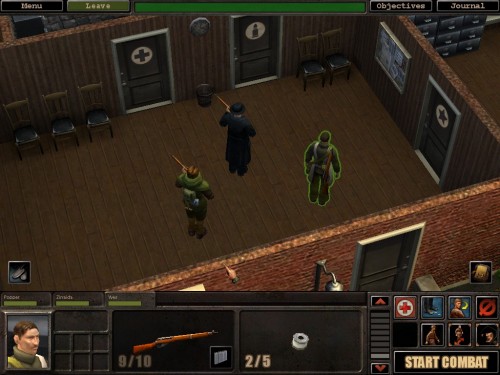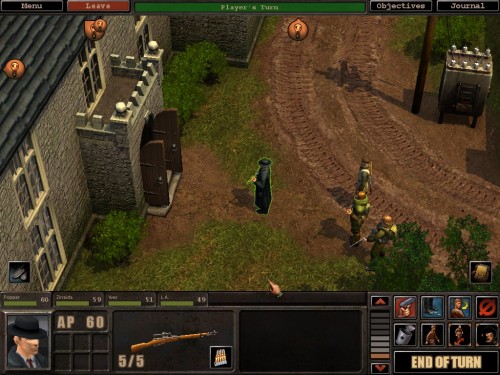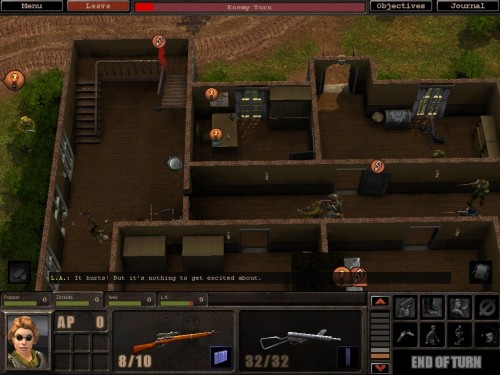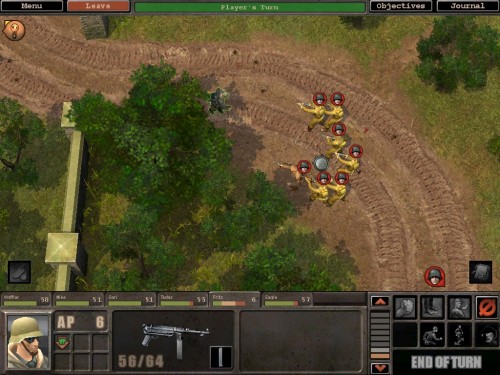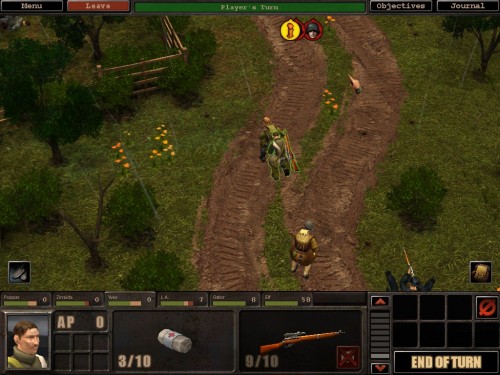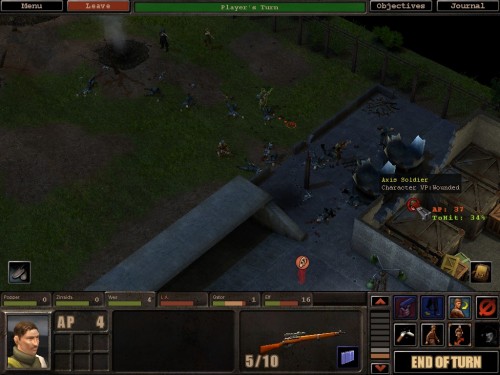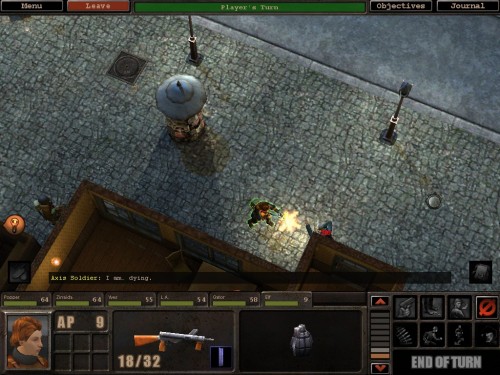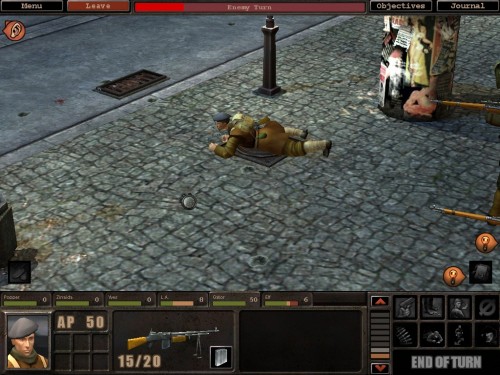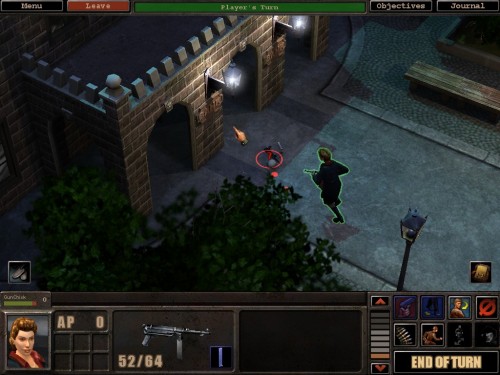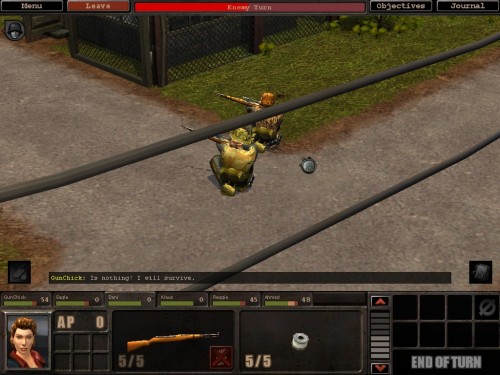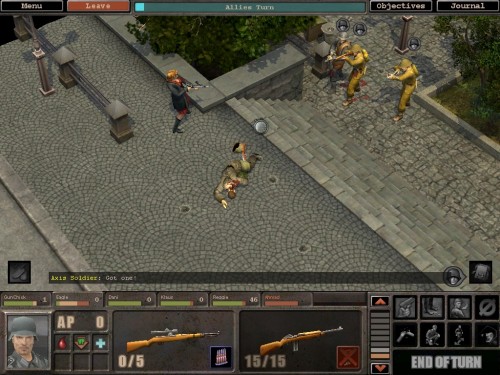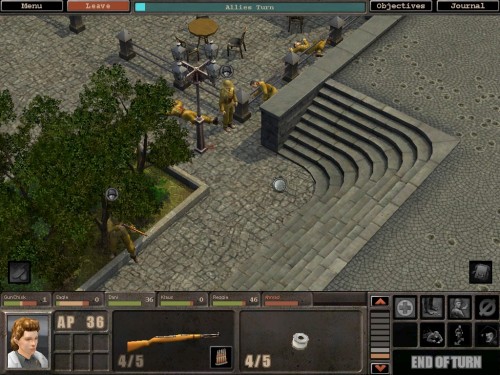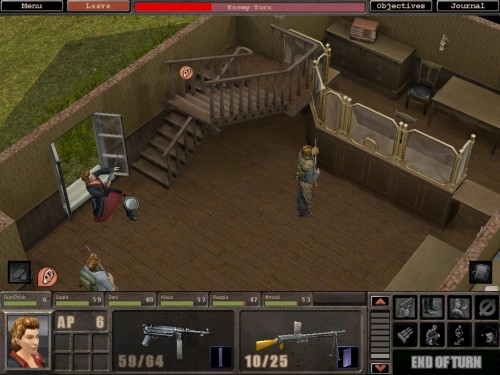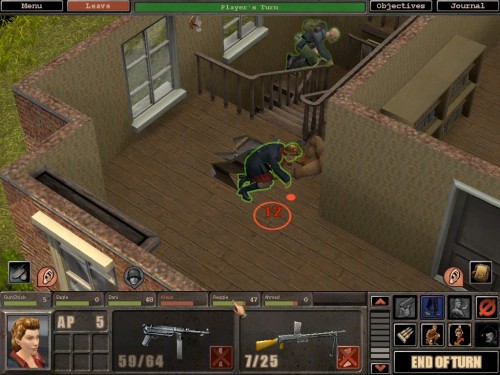Silent Storm Review
Silent Storm Review
Codex Review - posted by Saint_Proverbius on Thu 5 February 2004, 18:39:10
Tags: Nival Interactive; Silent StormOur review of Silent Storm. Basically, it's cool. I liked it. That didn't stop me from making a few complaints, though! Here's one of them:
Additionally, you can blow up walls and structures with mines and grenades. You can plant explosive traps in windows, doors, and other devices you can directly interact with in order to bring the house down. Of course, this tends to kill anyone in the building, so it's an expensive way of wiping out a nest of snipers sitting in an attic loft rather than risking other methods of direct confrontation. The only major problem with this is that you can't plant explosives directly on walls themselves. You have to plant them in the doors, windows, and so on or on the ground. It would have been nice to be able to blow up a support column by slapping a charge directly on the column itself and running.
I hate limits on my ability to blow stuff up!
Additionally, you can blow up walls and structures with mines and grenades. You can plant explosive traps in windows, doors, and other devices you can directly interact with in order to bring the house down. Of course, this tends to kill anyone in the building, so it's an expensive way of wiping out a nest of snipers sitting in an attic loft rather than risking other methods of direct confrontation. The only major problem with this is that you can't plant explosives directly on walls themselves. You have to plant them in the doors, windows, and so on or on the ground. It would have been nice to be able to blow up a support column by slapping a charge directly on the column itself and running.
I hate limits on my ability to blow stuff up!
The war to end all wars.. again!
There's been a hell of a lot of World War II themed games lately, in nearly every genre. Seems like nearly everyone has a game set in that war coming out. I guess that's okay, it wasn't that popular of a setting until recently, and it hasn't really been that popular of a setting for role playing games, dungeon crawler or otherwise. So far, all of them have come from Europe, like Another War came from developers in Poland.
Silent Storm is the latest CRPG from Russia, one that focuses on tactical combat rather than other solutions. Keeping with the setting, this game takes place all over Europe in an alternative 1943. Instead of your typical dungeon as seen in most dungeon crawlers, you have basically what you'd expect - military bases, houses, barns, and other semi-modern structures you can move to and from looking for quest items as well as enemies. The more quest items, which are listed in the Objectives menu, you find, the more locations the game will spawn for you to complete.
The basic set up
There are two sides in Silent Storm, naturally. The Axis and the Allies, which will determine the campaign you'll have and what weapons and ammo your base will stock, and the nationalities of your party members. Other than that, there's not any difference between the two in terms of actual mechanics of the game. What does determine the mechanics of how you play are the classes you can choose to make up your party. There are six classes, Sniper, Soldier, Medic, Grenadier, Engineer, and Scout. While many of these classes share similar Abilities, the order of the abilities and prerequisites are different based on the focus of the class. For example, a Scout is much easier to make a melee master than a Medic, even though both classes share these Abilities.
The Sniper is pretty much what you'd expect. It's a class that focuses on the use of single shot weapons, and doing the most damage with them. There's an entire skill tree branch for this class devoted to improving critical hits. This class also gets various abilities to take aim over the course of several turns in order to improve the shot they're trying to make.
The Soldier is what you'd expect him or her to be, the one that specializes in the big, bad guns. Basically, this is the class you want your machine gun people to be, because this class get various abilities based on burst fire.
The Medic is your basic healing and augmentation class. They can treat injuries to a certain extent by restoring vitality points, but can also cure things like bleeding, blindness and other things. As an extra bonus, they can also drug up your party members in order to boost their abilities temporarily. They also have a number of abilities devoted to melee attacks.
The Engineer is your basic lockpicking and trap specialist. While not as notable in the combat areas, this class is fairly good at finding those nasty explosive traps the enemy tends to leave in doors, chests, and other things your party may want to open. They can also disarm those traps for later use. This class also has the most abilities you can have specifically for use with the Panzerklien power armor.
Scouts are your more stealthy killers, favoring silent killing typically with a melee weapon. They also have a number of abilities which will augment their speed and senses allowing them to detect and take out enemies more quickly. This class also has a handy ability allowing them do more damage when attacking an enemy that can't see them, similar to a backstab attack.
The Grenadier is similar to the Soldier, only focused more on grenades as well as heavy weapons of destruction and mayhem.
While you have six classes to pick from, and many of them have advantages and disadvantages, Some classes are a little more gung ho than others, and since the game is technically over when your lead character dies, you may want to pick something less gung ho for your main character's class. A Sniper tends to be a good class for the main character because they hang back from the battles, picking off enemies from long range while a Grenadier tends to be very up close and personal in the thick of battle. Of course, this all depends on play style and how carefully you use your characters.
Being different from the pack
About the big claim to customizing your character in this game at the start is how you look. You can select gender, your clothing which you can't ever change in the game, and which head you want to use. If you're not happy with the preset heads, there's the option of making a custom head for your character. You can edit things like chin shape, brow shape, nose shape, add scars, add glasses, select a nationality look, and so forth. That said, it doesn't really do anything in the game itself, but you're going to be staring at that head every time you talk to someone.
The attributes for characters isn't the most advanced part of the system, unfortunately. You only have three main ones, Strength, Intelligence, and Dexterity. These attributes handle themselves in a familiar fashion to other CRPGs, like Strength is important for melee damage as well as carry weight while Dexterity determines Action Points as well as modifying ranged combat prowess. These attributes also will go up during the course of the game. Secondary attributes include Action Points, Vitality Points, and Evasion.
Depending on which class you picked, it allots starting attribute points based on what the designers think is ideal for that class. You are, however, free to lower one attribute and boost another if you feel the need to have a medic with a higher Dexterity for shooting while lowering his Strength or Intelligence.
All classes have the same set of skills but vary in Abilities, which act similar to Fallout's Perks. Skills will progress through usage, so the more you use a particular skill on a party member, the better that party member will be with that skill. Also, the higher the Intelligenceof the party member, the faster these skills progress. This does give an advantage to the "smarter" classes in that they can eventually become decent at other skills, but they won't have the advantages of the Abilities present in classes that excel in those skills.
Since this game is a tactical type game, nearly all of the skills involve combat. In fact, of the ten skills, you have five devoted to dishing out damage - Shooting, Melee, Throwing, Snipe, and Burst. Of the other five, you have things like Hide, which will give allow you to sneak up on unsuspecting enemies or avoid them entirely. Spot will allow you to detect hidden traps as well as enemies that are around you. Engineering is the skill that determines how well you can use a lockpick and set up explosive traps for the enemy. When you're low on Vitality Points or have a more serious injury, Medicine can come in quite handy. While the last skill is certainly a combat one, Interrupt determines how well you can react during an enemy's turn if they come in to view.
There is no way to adjust the starting skills, however, so in terms of those, all players of a class start out with the same basic skills set up so there is no customization on this aspect. One big note though, Engineering seems to go up very, very slowly. You're almost forced in to tagging Abilities centered on this skill just to get much use out of an Engineer because of how slowly this skill advances. Good luck picking a lock early in the game, too. It probably won't happen.
Abilities are the big thing that will allow your characters to customize themselves through the course of the game, however. They can have effects such as from faster skill advancement, changing the time it takes to perform actions, boosting skills directly by a certain percentage, granting characters additional features, etc.
Travelling through Europe
Silent Storm is basically a mission based game with a world map. You travel the world map from your landing zone to areas of interest which are highlighted on the map. At times, you may be given a number of locations to visit and objectives to complete. If you do a mission that generates multiple pieces of information, this can lead to multiple mission points the next time around. This gives you a choice in how to play through the game and in what order what things get done. However, it's rather superficial in nature, since all routes lead to the same conclusion. Of course, this is par for the course in a dungeon crawler, and the mission tree system does allow a bit of replay value.
Another thing that adds reply value is that while the missions are the same in each game, the order of them isn't. That means you can start off with a certain mission in one game, and get a completely different mission in another. Also, since there's two campaigns for each side of the war, you may encounter a mission in one campaign that's set in the exact same location with the exact same circumstances, only you're playing it from the other side's point of view. This allows for some very interesting behind the scenes details.
Between missions, each side has their own base where your party can recruit additional party members, restock ammo, and get healing. Unfortunately, this base aspect seems a little pointless for doing much else other than getting some additional ammo and supplies. The medical bay really doesn't seem to do much beyond the first few missions, and that's mainly to go from a bandaged state to a fully healthy state. Of course, this depends on the difficulty level, so the easier you make the game, the more useless the medical bay gets.
It would have been nice, since this game supports a bit of sci-fi to it's World War II theme to have allowed you to bring back technology from the battlefield and research it at the base. Heck, anything to make the base more interesting would have been nice. A debriefing from the base commander, letters from home for the party members you recruit, or any nice touch of a reason to go there other than getting more bandages and bullets.
One quirk is that your party members don't seem to advance as fast as the ones who stick around the base. You may want to swap them out every so often because of this, because sitting around the base seems to make them learn faster than actually being in the field. Since none of them express much in the way of a personality, there's very little to get attached to them. This is where the letters from home would have been nice.
While there is some looting in the game, your base doesn't buy weapons. In fact, there's no money in the game at all, so there's not much point to collecting everything on the missions and carrying them back. Sure, you'll find some things that are useful, like medical supplies and perhaps a new gun here and there. However, if the gun isn't a type of gun listed as your side of origin, your base won't stock ammo for it. Even though most of the loot and bounty you'll find is enemy goods, it's still useful to scan around with the ALT key to make sure you're not missing anything. Your base will only stock so many lockpicks and bandages, so it's important to find them while you're out.
Most missions are fairly straight forward. You go in, you find a person or an item, and you collect them. While this may sound bland, there's actually a few interesting twists involved, often handled by the design of the maps themselves. You may be inserted in to a base in the middle of the night to steal some plans or you may be visiting a mansion in search of a spy for the other side.
One thing I was disappointed in is that there are several missions where they start off talking and things just go downhill from there. It would have been nice if the game had an actual dialogue system as opposed to the canned cut scene speeches. In fact, even adding a bit of a speech skill would have gone a long way to making this more interesting - allowing a player to develop diplomatic methods for making missions easier by recruiting civilians to help out, or even talking enemies in to surrendering. One particular mission involving accusations flying back and forth as to who the real spy is could have been made far more interesting with a little charm and diplomacy.
Another disappointing this is that while locations you've completed stay on the map, you can never return to them once they've been done. That means that if you forget something like an unconscious party member's weapon they dropped, it's gone for good. There's no backtracking maps looking for ammo for your enemy weapon you picked up and decided you liked, either.
The March of War
Silent Storm is mainly a tactical game/dungeon crawler. This basically means the majority of the time, you're going to be fighting something. Luckily, the game provides a very nice combat system. It's turn based, which means you have full control over your party members based upon their statistics the entire time you're playing. There is no automation, what happens is primarily based upon what you do.
For those familiar with turn based games like Fallout, Jagged Alliance 2, and others, you shouldn't have a hard time getting used to the combat system in this game. Then again, even if you haven't, the system is straight forward. Like the ones mentioned, all actions in a given turn are based on the amount of Action Points your characters have. The more Action Points, the more things you can do during this time. Additionally, if you're a Sniper character, the more Action Points you have, the more like you are to hit something if you spend your full turn aiming and firing.
About the only problem with this turn based system is there isn't a way to speed up the animations of the NPCs. Because of this, the time between your turns can seem to take a very, very long time. Every movement is done and animated whether or not you can actually see it happening. A movement speed slider would have been a very nice addition to this game.
This game also features stances, meaning that you can run, walk, crouch, or go prone. Running is the fastest stance and will allow you to cover ground very quickly. However, while running, you won't be able to side-step and you'll also be making a heck of a lot of noise which will attract enemy soldiers to your position. On the other end, there's prone, which moves very, very slowly but it nearly silent. Stances also help your cover rating, which affects your ability to be hit. Certain weapons also work better with certain stances, so there might be penalties and bonuses associated for using them with those weapons. Grenade throwing is very much affected by this, and can determine how the grenade actually lands and what it does when it lands.
In addition to standard weapons that your party carries with them, there are also fixed weapons on some maps. These weapons can't be moved, but creating a diversion can lead an enemy in to the line of fire of one of these weapons allowing you to mow them down with ease. These guns are generally so powerful, they can chew up brick walls, but more on that later.
Most every ranged weapon in the game has several modes of use. A rifle, for example, has three modes based on how long you wish to aim. Snipers can use a forth mode as well. Submachine guns and machine guns typically have a short burst and a full burst, and some weapons have burst modes as well as single shot modes. Depending on what you want to do, there is a weapon with the options you're probably looking to have.
Also, the more you use a weapon, the better you'll get with it. This means that if you stick with one weapon through the course of the game, you can get advantages based on all the experience with it you have. In fact, there are even certain classes that have Abilities that can increase the rate of Familiarization with a weapon, allowing you to get these bonuses quicker should you decide to tag them.
You might have a little trouble figuring out what weapons do what based on the names alone. Often times, you'll have to pick them up and look at the statistics for the weapons. Once you look at them, the statistics should be fairly clear on what they do, as the pop up help will display nearly everything you need to know about the item in question. It even displays the interesting tidbits like the bonus to criticals that melee weapons will give.
Another nice thing about Silent Storm is the AI. If an enemy hears you moving around or firing your weapon, they'll react to it and move to intercept. Anything that makes a noise that an enemy can hear will cause them to seek it out. Even friendly NPCs will seek out an unidentified noise. While this can work against you if you're the kick in the doors and shoot everything up kind of player, it does allow the more devious player an outlet for mayhem. Set a few mines in a corner and fire your pistol just around the corner. Stand back and wait. Of course, the downside would be that this can also attract civilians to their doom as well, since civilians seem to use the same curious AI making them sniff out any noises going on.
One interesting quirk is that all the canned speech during the battle is the same. On some missions, you'll be fighting enemy civilians that are armed. Since they use the default civilian speech, you end up being attacked by people saying such things as, "We mean you no harm!" and, "They have no respect for human life!"
Along those lines, the game also provides you with numerous ways of killing silently, for those who like to practice their stealthy killing. Many of the smaller arms can be acquired with silencers, allowing a few Scouts to ambush and slaughter a few hostiles without stirring up the hornet's nest. When you don't have silenced weapons, there's always throwing knives, throwing stars, or just sneaking up on someone and gutting them from behind.
Of course, I tend to favor the big bang style, blowing things up, bursting the enemies, and generally creating a huge mess. That's when I noticed one thing, grenades are gimped simply because of the amount of inventory space they take up. Four standard fragmentation grenades take up as much room in your backpack as a rifle. Grenades aren't the only items that are oddly oversized, either. Lockpicks are pretty large and can only be used five times a piece. However, that said, there's nothing better than a grenade to take out multiple enemies who clump up together.
Of course, I still enjoy a little sniping while my soldiers are advancing, and this game offers some interesting possibilities. The main one of note is the ability to charge up a shot over several turns to improve the aim of the shot. The more AP you sink in to the shot, the more likely you are to hit and the better the hit will be. You can even use the hit location system to specify a head shot for that instant kill action if you're so inclined.
When terrain is cool
Probably the biggest feature of this game is the interaction with terrain in the game. You can climb through windows, up through holes in a ceiling or down through the floor. You can hop over a banister on some stairs. You can open windows for a clearer shot or jump down a story to surprise an enemy. About the only thing you can't really do is come down the chimney.
In addition to hopping obstacles, you can also use them for cover. If a bullet has been determined to hit you, but something is in the way of that, the bullet will hit that instead. That bullet will also damage the object between you and it, and nearly everything in the game can be destroyed. It's not uncommon to burst fire at an enemy that's behind a fence only to see the fence splinter and the enemy take damage. It's much better to be behind the brick wall than the wooden fence, that's for sure.
Once you start getting used to the way bullets can eat up surfaces, you can use this to your advantage as well. If the enemy is behind a wooden door, no problem! Just shoot through it! Of course, this will destroy the door in the process, but who really cares? It's someone else's house, anyway. Doors aren't the only things that will give way to hot lead, either. A wooden ceiling with an enemy walking around on the floor above can also be shot through, given the right weapon. A good sniper rifle can send a round right through that floor or a burst weapon can tear a chunk in both the floor and the enemy standing on it.
It's not just terrain that bullets can pass through, either. If you have several enemies in a row, a Sniper can put a bullet through several of them before it comes to rest in one of them. Two snipers at the end of a long, narrow hall the enemy is coming down is a recipe for racking up the experience with little fuss.
Additionally, you can blow up walls and structures with mines and grenades. You can plant explosive traps in windows, doors, and other devices you can directly interact with in order to bring the house down. Of course, this tends to kill anyone in the building, so it's an expensive way of wiping out a nest of snipers sitting in an attic loft rather than risking other methods of direct confrontation. The only major problem with this is that you can't plant explosives directly on walls themselves. You have to plant them in the doors, windows, and so on or on the ground. It would have been nice to be able to blow up a support column by slapping a charge directly on the column itself and running.
Though it doesn't have much impact on actual gameplay, it's rather interesting what happens to bodies when they die. If someone is shot near a fence, they may fall back on to the fence only to be propped up on it like a disturbing meat scarecrow. Take out the floor under an enemy who dies in the process, and watch the limp, sagging body plunge to the floor below.
And finally, the end.
Silent Storm is a great little World War II themed dungeon crawler. While it does have a few quirks here and there, and there are some areas I'd love to see better developed, the experience overall is that of a damned fine game with a damned fine combat system. In fact, the combat system is the cornerstone of this game, and it works surprisingly well. You may find yourself a little bored between turns if there's a lot of enemies and allies running around, but the amount of things you can do during combat makes up for any downside there.
I would have liked the mission areas to be larger with more stuff to do in them, and I would have liked the game outside those missions to offer more. I would have also liked something that established my party members in greater detail - who they are, what they want, why they're there. Just a little something other than a brief bio in order to give them an identity. That said, what it does offer in those missions can be pretty fun. There are a multitude of tactics afforded by the design of this game, so if you're looking for the next best thing to Jagged Alliance 2, then this is it.
There's been a hell of a lot of World War II themed games lately, in nearly every genre. Seems like nearly everyone has a game set in that war coming out. I guess that's okay, it wasn't that popular of a setting until recently, and it hasn't really been that popular of a setting for role playing games, dungeon crawler or otherwise. So far, all of them have come from Europe, like Another War came from developers in Poland.
Silent Storm is the latest CRPG from Russia, one that focuses on tactical combat rather than other solutions. Keeping with the setting, this game takes place all over Europe in an alternative 1943. Instead of your typical dungeon as seen in most dungeon crawlers, you have basically what you'd expect - military bases, houses, barns, and other semi-modern structures you can move to and from looking for quest items as well as enemies. The more quest items, which are listed in the Objectives menu, you find, the more locations the game will spawn for you to complete.
The basic set up
There are two sides in Silent Storm, naturally. The Axis and the Allies, which will determine the campaign you'll have and what weapons and ammo your base will stock, and the nationalities of your party members. Other than that, there's not any difference between the two in terms of actual mechanics of the game. What does determine the mechanics of how you play are the classes you can choose to make up your party. There are six classes, Sniper, Soldier, Medic, Grenadier, Engineer, and Scout. While many of these classes share similar Abilities, the order of the abilities and prerequisites are different based on the focus of the class. For example, a Scout is much easier to make a melee master than a Medic, even though both classes share these Abilities.
The Sniper is pretty much what you'd expect. It's a class that focuses on the use of single shot weapons, and doing the most damage with them. There's an entire skill tree branch for this class devoted to improving critical hits. This class also gets various abilities to take aim over the course of several turns in order to improve the shot they're trying to make.
The Soldier is what you'd expect him or her to be, the one that specializes in the big, bad guns. Basically, this is the class you want your machine gun people to be, because this class get various abilities based on burst fire.
The Medic is your basic healing and augmentation class. They can treat injuries to a certain extent by restoring vitality points, but can also cure things like bleeding, blindness and other things. As an extra bonus, they can also drug up your party members in order to boost their abilities temporarily. They also have a number of abilities devoted to melee attacks.
The Engineer is your basic lockpicking and trap specialist. While not as notable in the combat areas, this class is fairly good at finding those nasty explosive traps the enemy tends to leave in doors, chests, and other things your party may want to open. They can also disarm those traps for later use. This class also has the most abilities you can have specifically for use with the Panzerklien power armor.
Scouts are your more stealthy killers, favoring silent killing typically with a melee weapon. They also have a number of abilities which will augment their speed and senses allowing them to detect and take out enemies more quickly. This class also has a handy ability allowing them do more damage when attacking an enemy that can't see them, similar to a backstab attack.
The Grenadier is similar to the Soldier, only focused more on grenades as well as heavy weapons of destruction and mayhem.
While you have six classes to pick from, and many of them have advantages and disadvantages, Some classes are a little more gung ho than others, and since the game is technically over when your lead character dies, you may want to pick something less gung ho for your main character's class. A Sniper tends to be a good class for the main character because they hang back from the battles, picking off enemies from long range while a Grenadier tends to be very up close and personal in the thick of battle. Of course, this all depends on play style and how carefully you use your characters.
Being different from the pack
About the big claim to customizing your character in this game at the start is how you look. You can select gender, your clothing which you can't ever change in the game, and which head you want to use. If you're not happy with the preset heads, there's the option of making a custom head for your character. You can edit things like chin shape, brow shape, nose shape, add scars, add glasses, select a nationality look, and so forth. That said, it doesn't really do anything in the game itself, but you're going to be staring at that head every time you talk to someone.
The attributes for characters isn't the most advanced part of the system, unfortunately. You only have three main ones, Strength, Intelligence, and Dexterity. These attributes handle themselves in a familiar fashion to other CRPGs, like Strength is important for melee damage as well as carry weight while Dexterity determines Action Points as well as modifying ranged combat prowess. These attributes also will go up during the course of the game. Secondary attributes include Action Points, Vitality Points, and Evasion.
Depending on which class you picked, it allots starting attribute points based on what the designers think is ideal for that class. You are, however, free to lower one attribute and boost another if you feel the need to have a medic with a higher Dexterity for shooting while lowering his Strength or Intelligence.
All classes have the same set of skills but vary in Abilities, which act similar to Fallout's Perks. Skills will progress through usage, so the more you use a particular skill on a party member, the better that party member will be with that skill. Also, the higher the Intelligenceof the party member, the faster these skills progress. This does give an advantage to the "smarter" classes in that they can eventually become decent at other skills, but they won't have the advantages of the Abilities present in classes that excel in those skills.
Since this game is a tactical type game, nearly all of the skills involve combat. In fact, of the ten skills, you have five devoted to dishing out damage - Shooting, Melee, Throwing, Snipe, and Burst. Of the other five, you have things like Hide, which will give allow you to sneak up on unsuspecting enemies or avoid them entirely. Spot will allow you to detect hidden traps as well as enemies that are around you. Engineering is the skill that determines how well you can use a lockpick and set up explosive traps for the enemy. When you're low on Vitality Points or have a more serious injury, Medicine can come in quite handy. While the last skill is certainly a combat one, Interrupt determines how well you can react during an enemy's turn if they come in to view.
There is no way to adjust the starting skills, however, so in terms of those, all players of a class start out with the same basic skills set up so there is no customization on this aspect. One big note though, Engineering seems to go up very, very slowly. You're almost forced in to tagging Abilities centered on this skill just to get much use out of an Engineer because of how slowly this skill advances. Good luck picking a lock early in the game, too. It probably won't happen.
Abilities are the big thing that will allow your characters to customize themselves through the course of the game, however. They can have effects such as from faster skill advancement, changing the time it takes to perform actions, boosting skills directly by a certain percentage, granting characters additional features, etc.
Travelling through Europe
Silent Storm is basically a mission based game with a world map. You travel the world map from your landing zone to areas of interest which are highlighted on the map. At times, you may be given a number of locations to visit and objectives to complete. If you do a mission that generates multiple pieces of information, this can lead to multiple mission points the next time around. This gives you a choice in how to play through the game and in what order what things get done. However, it's rather superficial in nature, since all routes lead to the same conclusion. Of course, this is par for the course in a dungeon crawler, and the mission tree system does allow a bit of replay value.
Another thing that adds reply value is that while the missions are the same in each game, the order of them isn't. That means you can start off with a certain mission in one game, and get a completely different mission in another. Also, since there's two campaigns for each side of the war, you may encounter a mission in one campaign that's set in the exact same location with the exact same circumstances, only you're playing it from the other side's point of view. This allows for some very interesting behind the scenes details.
Between missions, each side has their own base where your party can recruit additional party members, restock ammo, and get healing. Unfortunately, this base aspect seems a little pointless for doing much else other than getting some additional ammo and supplies. The medical bay really doesn't seem to do much beyond the first few missions, and that's mainly to go from a bandaged state to a fully healthy state. Of course, this depends on the difficulty level, so the easier you make the game, the more useless the medical bay gets.
It would have been nice, since this game supports a bit of sci-fi to it's World War II theme to have allowed you to bring back technology from the battlefield and research it at the base. Heck, anything to make the base more interesting would have been nice. A debriefing from the base commander, letters from home for the party members you recruit, or any nice touch of a reason to go there other than getting more bandages and bullets.
One quirk is that your party members don't seem to advance as fast as the ones who stick around the base. You may want to swap them out every so often because of this, because sitting around the base seems to make them learn faster than actually being in the field. Since none of them express much in the way of a personality, there's very little to get attached to them. This is where the letters from home would have been nice.
While there is some looting in the game, your base doesn't buy weapons. In fact, there's no money in the game at all, so there's not much point to collecting everything on the missions and carrying them back. Sure, you'll find some things that are useful, like medical supplies and perhaps a new gun here and there. However, if the gun isn't a type of gun listed as your side of origin, your base won't stock ammo for it. Even though most of the loot and bounty you'll find is enemy goods, it's still useful to scan around with the ALT key to make sure you're not missing anything. Your base will only stock so many lockpicks and bandages, so it's important to find them while you're out.
Most missions are fairly straight forward. You go in, you find a person or an item, and you collect them. While this may sound bland, there's actually a few interesting twists involved, often handled by the design of the maps themselves. You may be inserted in to a base in the middle of the night to steal some plans or you may be visiting a mansion in search of a spy for the other side.
One thing I was disappointed in is that there are several missions where they start off talking and things just go downhill from there. It would have been nice if the game had an actual dialogue system as opposed to the canned cut scene speeches. In fact, even adding a bit of a speech skill would have gone a long way to making this more interesting - allowing a player to develop diplomatic methods for making missions easier by recruiting civilians to help out, or even talking enemies in to surrendering. One particular mission involving accusations flying back and forth as to who the real spy is could have been made far more interesting with a little charm and diplomacy.
Another disappointing this is that while locations you've completed stay on the map, you can never return to them once they've been done. That means that if you forget something like an unconscious party member's weapon they dropped, it's gone for good. There's no backtracking maps looking for ammo for your enemy weapon you picked up and decided you liked, either.
The March of War
Silent Storm is mainly a tactical game/dungeon crawler. This basically means the majority of the time, you're going to be fighting something. Luckily, the game provides a very nice combat system. It's turn based, which means you have full control over your party members based upon their statistics the entire time you're playing. There is no automation, what happens is primarily based upon what you do.
For those familiar with turn based games like Fallout, Jagged Alliance 2, and others, you shouldn't have a hard time getting used to the combat system in this game. Then again, even if you haven't, the system is straight forward. Like the ones mentioned, all actions in a given turn are based on the amount of Action Points your characters have. The more Action Points, the more things you can do during this time. Additionally, if you're a Sniper character, the more Action Points you have, the more like you are to hit something if you spend your full turn aiming and firing.
About the only problem with this turn based system is there isn't a way to speed up the animations of the NPCs. Because of this, the time between your turns can seem to take a very, very long time. Every movement is done and animated whether or not you can actually see it happening. A movement speed slider would have been a very nice addition to this game.
This game also features stances, meaning that you can run, walk, crouch, or go prone. Running is the fastest stance and will allow you to cover ground very quickly. However, while running, you won't be able to side-step and you'll also be making a heck of a lot of noise which will attract enemy soldiers to your position. On the other end, there's prone, which moves very, very slowly but it nearly silent. Stances also help your cover rating, which affects your ability to be hit. Certain weapons also work better with certain stances, so there might be penalties and bonuses associated for using them with those weapons. Grenade throwing is very much affected by this, and can determine how the grenade actually lands and what it does when it lands.
In addition to standard weapons that your party carries with them, there are also fixed weapons on some maps. These weapons can't be moved, but creating a diversion can lead an enemy in to the line of fire of one of these weapons allowing you to mow them down with ease. These guns are generally so powerful, they can chew up brick walls, but more on that later.
Most every ranged weapon in the game has several modes of use. A rifle, for example, has three modes based on how long you wish to aim. Snipers can use a forth mode as well. Submachine guns and machine guns typically have a short burst and a full burst, and some weapons have burst modes as well as single shot modes. Depending on what you want to do, there is a weapon with the options you're probably looking to have.
Also, the more you use a weapon, the better you'll get with it. This means that if you stick with one weapon through the course of the game, you can get advantages based on all the experience with it you have. In fact, there are even certain classes that have Abilities that can increase the rate of Familiarization with a weapon, allowing you to get these bonuses quicker should you decide to tag them.
You might have a little trouble figuring out what weapons do what based on the names alone. Often times, you'll have to pick them up and look at the statistics for the weapons. Once you look at them, the statistics should be fairly clear on what they do, as the pop up help will display nearly everything you need to know about the item in question. It even displays the interesting tidbits like the bonus to criticals that melee weapons will give.
Another nice thing about Silent Storm is the AI. If an enemy hears you moving around or firing your weapon, they'll react to it and move to intercept. Anything that makes a noise that an enemy can hear will cause them to seek it out. Even friendly NPCs will seek out an unidentified noise. While this can work against you if you're the kick in the doors and shoot everything up kind of player, it does allow the more devious player an outlet for mayhem. Set a few mines in a corner and fire your pistol just around the corner. Stand back and wait. Of course, the downside would be that this can also attract civilians to their doom as well, since civilians seem to use the same curious AI making them sniff out any noises going on.
One interesting quirk is that all the canned speech during the battle is the same. On some missions, you'll be fighting enemy civilians that are armed. Since they use the default civilian speech, you end up being attacked by people saying such things as, "We mean you no harm!" and, "They have no respect for human life!"
Along those lines, the game also provides you with numerous ways of killing silently, for those who like to practice their stealthy killing. Many of the smaller arms can be acquired with silencers, allowing a few Scouts to ambush and slaughter a few hostiles without stirring up the hornet's nest. When you don't have silenced weapons, there's always throwing knives, throwing stars, or just sneaking up on someone and gutting them from behind.
Of course, I tend to favor the big bang style, blowing things up, bursting the enemies, and generally creating a huge mess. That's when I noticed one thing, grenades are gimped simply because of the amount of inventory space they take up. Four standard fragmentation grenades take up as much room in your backpack as a rifle. Grenades aren't the only items that are oddly oversized, either. Lockpicks are pretty large and can only be used five times a piece. However, that said, there's nothing better than a grenade to take out multiple enemies who clump up together.
Of course, I still enjoy a little sniping while my soldiers are advancing, and this game offers some interesting possibilities. The main one of note is the ability to charge up a shot over several turns to improve the aim of the shot. The more AP you sink in to the shot, the more likely you are to hit and the better the hit will be. You can even use the hit location system to specify a head shot for that instant kill action if you're so inclined.
When terrain is cool
Probably the biggest feature of this game is the interaction with terrain in the game. You can climb through windows, up through holes in a ceiling or down through the floor. You can hop over a banister on some stairs. You can open windows for a clearer shot or jump down a story to surprise an enemy. About the only thing you can't really do is come down the chimney.
In addition to hopping obstacles, you can also use them for cover. If a bullet has been determined to hit you, but something is in the way of that, the bullet will hit that instead. That bullet will also damage the object between you and it, and nearly everything in the game can be destroyed. It's not uncommon to burst fire at an enemy that's behind a fence only to see the fence splinter and the enemy take damage. It's much better to be behind the brick wall than the wooden fence, that's for sure.
Once you start getting used to the way bullets can eat up surfaces, you can use this to your advantage as well. If the enemy is behind a wooden door, no problem! Just shoot through it! Of course, this will destroy the door in the process, but who really cares? It's someone else's house, anyway. Doors aren't the only things that will give way to hot lead, either. A wooden ceiling with an enemy walking around on the floor above can also be shot through, given the right weapon. A good sniper rifle can send a round right through that floor or a burst weapon can tear a chunk in both the floor and the enemy standing on it.
It's not just terrain that bullets can pass through, either. If you have several enemies in a row, a Sniper can put a bullet through several of them before it comes to rest in one of them. Two snipers at the end of a long, narrow hall the enemy is coming down is a recipe for racking up the experience with little fuss.
Additionally, you can blow up walls and structures with mines and grenades. You can plant explosive traps in windows, doors, and other devices you can directly interact with in order to bring the house down. Of course, this tends to kill anyone in the building, so it's an expensive way of wiping out a nest of snipers sitting in an attic loft rather than risking other methods of direct confrontation. The only major problem with this is that you can't plant explosives directly on walls themselves. You have to plant them in the doors, windows, and so on or on the ground. It would have been nice to be able to blow up a support column by slapping a charge directly on the column itself and running.
Though it doesn't have much impact on actual gameplay, it's rather interesting what happens to bodies when they die. If someone is shot near a fence, they may fall back on to the fence only to be propped up on it like a disturbing meat scarecrow. Take out the floor under an enemy who dies in the process, and watch the limp, sagging body plunge to the floor below.
And finally, the end.
Silent Storm is a great little World War II themed dungeon crawler. While it does have a few quirks here and there, and there are some areas I'd love to see better developed, the experience overall is that of a damned fine game with a damned fine combat system. In fact, the combat system is the cornerstone of this game, and it works surprisingly well. You may find yourself a little bored between turns if there's a lot of enemies and allies running around, but the amount of things you can do during combat makes up for any downside there.
I would have liked the mission areas to be larger with more stuff to do in them, and I would have liked the game outside those missions to offer more. I would have also liked something that established my party members in greater detail - who they are, what they want, why they're there. Just a little something other than a brief bio in order to give them an identity. That said, what it does offer in those missions can be pretty fun. There are a multitude of tactics afforded by the design of this game, so if you're looking for the next best thing to Jagged Alliance 2, then this is it.





